The Desktop Kabini Review Part 1: AMD Athlon 5350 (AM1) Tested
by Ian Cutress on April 9, 2014 8:00 AM ESTCPU Benchmarks
Console Emulation – Dolphin Benchmark: link
At the start of 2014 I was emailed with a link to a new emulation benchmark based on the Dolphin Emulator. The issue with emulators tends to be two-fold: game licensing and raw CPU power required for the emulation. As a result, many emulators are often bound by single thread CPU performance, and general reports tended to suggest that Haswell provided a significant post to emulator performance. This benchmark runs a Wii program that raytraces a complex 3D scene inside the Dolphin Wii emulator. Performance on this benchmark is a good proxy of the speed of Dolphin CPU emulation, which is an intensive single core task using most aspects of a CPU. Results are given in minutes, where the Wii itself scores 17.53; meaning that anything above this is faster than an actual Wii for processing Wii code, albeit emulated.
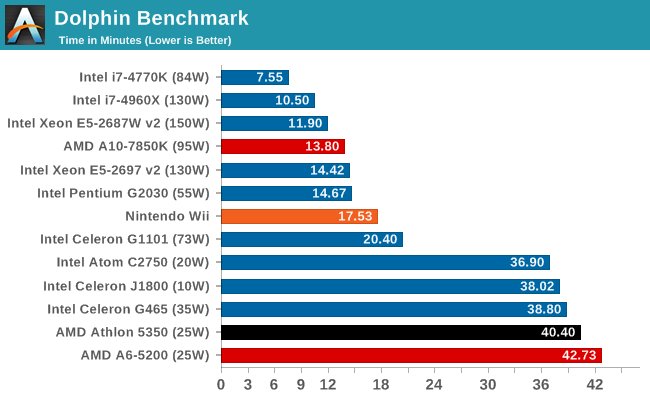
Point Calculations – 3D Movement Algorithm Test: link
3DPM is a self-penned benchmark, taking basic 3D movement algorithms used in Brownian Motion simulations and testing them for speed. High floating point performance, MHz and IPC wins in the single thread version, whereas the multithread version has to handle the threads and loves more cores.
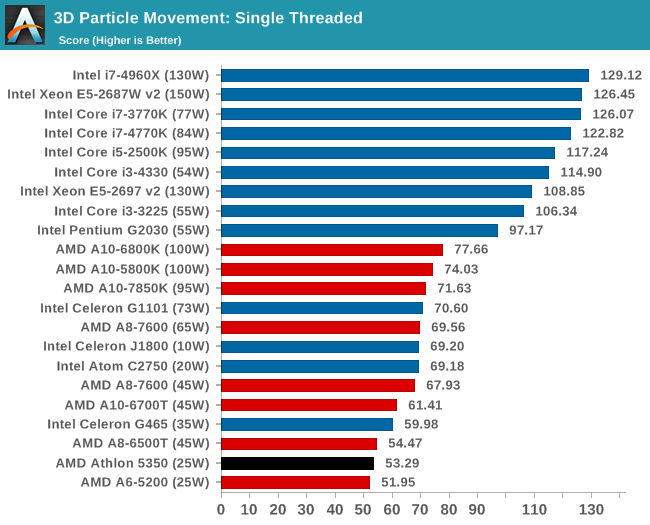
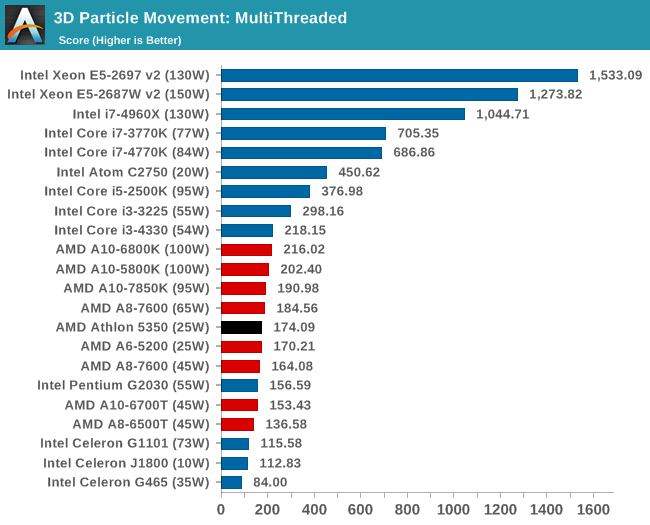
Encryption –TrueCrypt v0.7.1a: link
TrueCrypt is an off the shelf open source encryption tool for files and folders. For our test we run the benchmark mode using a 1GB buffer and take the mean result from AES encryption.
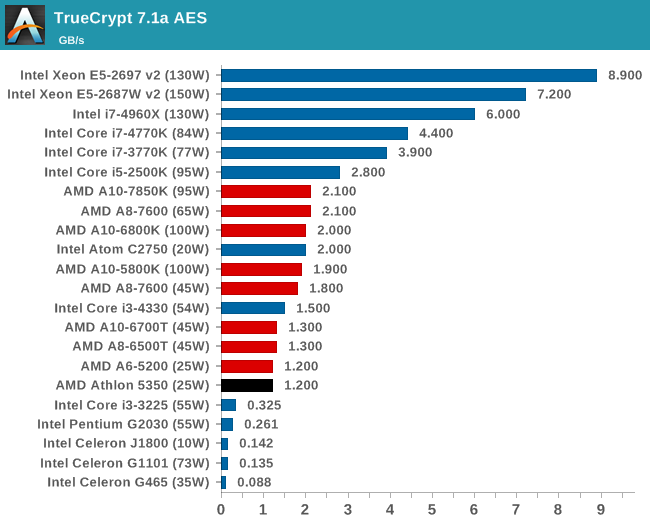
Synthetic – 7-Zip 9.2: link
As an open source compression tool, 7-Zip is a popular tool for making sets of files easier to handle and transfer. The software offers up its own benchmark, to which we report the result.
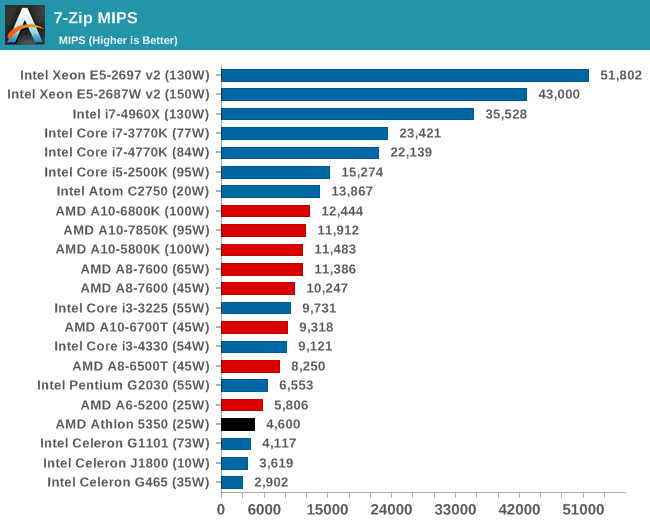
Rendering – PovRay 3.7: link
The Persistence of Vision RayTracer, or PovRay, is a freeware package for as the name suggests, ray tracing. It is a pure renderer, rather than modeling software, but the latest beta version contains a handy benchmark for stressing all processing threads on a platform. We have been using this test in motherboard reviews to test memory stability at various CPU speeds to good effect – if it passes the test, the IMC in the CPU is stable for a given CPU speed. As a CPU test, it runs for approximately 2-3 minutes on high end platforms.
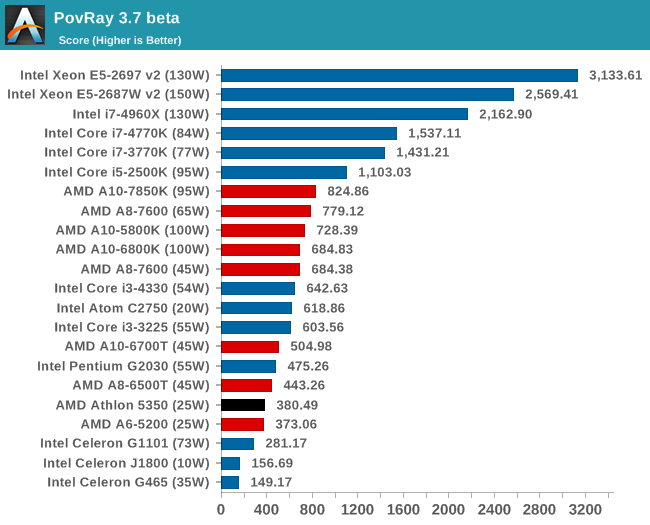










126 Comments
View All Comments
Medallish - Wednesday, April 9, 2014 - link
Well sadly it's not $35, but $59 But it does come with two extra Sata III ports, and the ability to plug a 19V DC directly into the boardhttp://www.newegg.com/Product/Product.aspx?Item=N8... Should be said the cable that comes along with it to supply drives with power directly from the motherboard, only supports 2 drives, so yeah if you do use that port you likely need to come up with an inventive way of supplying 2 additional drives.
If I were building a mini server though I'd likely to a little crazy and get this:
http://www.newegg.com/Product/Product.aspx?Item=N8...
6x Sata III ports and 1x mSata & 1x eSata. And then get some Richland or Kaveri APU as cheap and low power as they get with onboard GPU.
I'm sure you'll get a lot of other replies with even better suggestions.
Communism - Wednesday, April 9, 2014 - link
Lol @ those prices,37 USD motherboard:
BIOSTAR H61MGV3 LGA 1155 Intel H61 Micro ATX
http://www.newegg.com/Product/Product.aspx?Item=N8...
43 USD CPU/GPU:
Intel Celeron G1610 2.60GHz LGA 1155 Processor
http://www.amazon.com/Intel-Celeron-2-60GHz-Proces...
Desktop Kabini is DOA for it's intended purpose.
Medallish - Wednesday, April 9, 2014 - link
I love it when people trot out a H61 based board like it renders Kabini useless, completely missing the fact that it compared to Kabini misses a lot, with H61 you only get USB 2.0 and Sata II.And then there's that wonderful 55W CPU you put in there that I'm sure doesn't even compare on GPU performance to the Kabini and only is slightly ahead in CPU bench's.
I built a kabini system using this case:
http://www.chieftec.eu/en/chassis/itx-tower/ix-01b...
And the Asrock board:
http://www.asrock.com/mb/AMD/AM1H-ITX/
I got a board with a lot more functions, and an incredibly simple build thanks to the DC-In port, and still incredibly cheap. Kabini is like the perfect build for a lot of my family members who still can get use out of newer standards like Sata III and USB 3.0
meacupla - Wednesday, April 9, 2014 - link
Do you really think the presence or not of SATA3 matters in such a low end system?USB3.0 is nice, however.
Medallish - Wednesday, April 9, 2014 - link
Might not be a selling point telling someone with no clue, that it has Sata III certainly, but IO performance adds to the "feel", and on that front I would definitely say it can matter.fokka - Wednesday, April 9, 2014 - link
sure i'd prefer sata3 too, but the IO performance you're talking about isn't hindered much by sata2. max throughput is capped in half, yes, but once you go random rw, sata2 shouldn't be the limiting factor.MrSpadge - Wednesday, April 9, 2014 - link
Once you're transferring at 270 MB/s (SATA2) the feeling is pretty good. And during installs & loads the CPU has to keep up, too.rudolphna - Wednesday, April 9, 2014 - link
Well. Here is the thing. I have a Celeron g1610 on a mATX b75m board that together cost me $105. I use our for network storage and as a plex server which is real-time h264 encoding. I tested it with handbrake. Under handbrake h264 encoding using the igp for display, the g1610 pulled a maximum of 17w according to coretemp, not 55 or anywhere close to it. It generally runs sub 10w, when doing a single plex encode.Medallish - Wednesday, April 9, 2014 - link
I really wouldn't count on Software to get a accurate meassure of that, and TDP != Power use, it simply refers to the cooling requirement, I'm pretty sure the 5350 and 5150 don't use the same amount of power, despite them both having a TDP of 25W.frozentundra123456 - Wednesday, April 9, 2014 - link
Upgradability is nice, but the problem is upgrade to what. Right now there is no real upgrade path, and it is unknown what and when the next upgrade will be. Seems like another very niche product, like the rest of AMD APUs, trying to use the graphics to leverage an advantage against higher power consumption and mediocre cpu performance. So far this strategy hasnt really been successful, as the marketplace shows. That could change as more apps use graphics, but IMO single core performance (and power consumption in a small envelope like this) is still king.